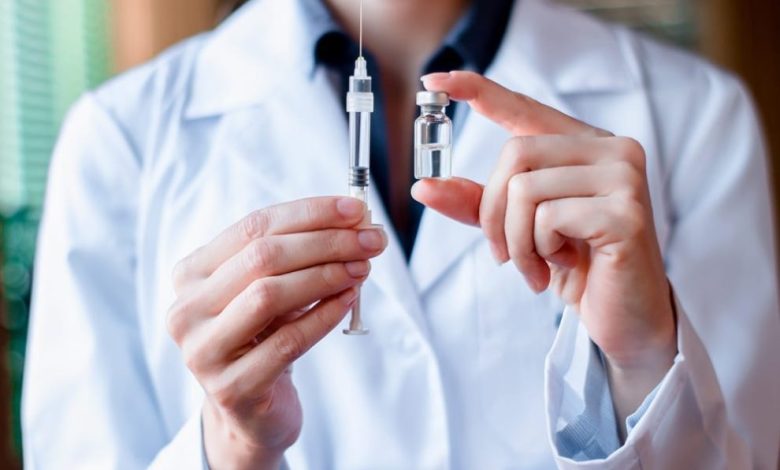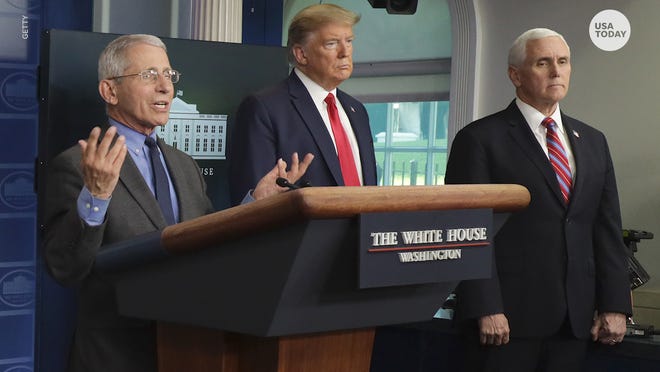In a series of breathtaking multibillion-dollar bets by vaccine makers, possible candidates to fight the new coronavirus are being prepared for production across the globe, before it’s even known whether any of them will work.

It’s one of the most dramatic examples of short cuts and streamlining aimed at meeting what many experts consider unrealistic U.S. target dates for a vaccine.
Director of the National Institute of Allergy and Infectious Diseases Anthony Fauci, front and center at White House news conferences, has repeatedly told a pandemic-weary nation a vaccine against the virus may be ready in 12 to 18 months.
That timeline would shatter all precedents for developing a new vaccine, which typically takes many years. The fastest it has ever been done was for mumps, which took four years.
“I think the goal of 18 months is one that will be very, very difficult to achieve,” said Michael Osterholm, director of the Center for Infectious Disease Research and Policy at the University of Minnesota. “But it just may be our moon shot.”
Manufacturing tens of millions of unproven vaccine doses on spec is unheard of in vaccine production. It underscores the urgent need to have solutionsready as quickly as possible to stop a scourge that has killed almost 200,000 people worldwide and decimated the global economy.
There is no certainty any of the experimental vaccines will work. If one does prove effective, getting it into the arms of people around the world will require another bold move:the Food and Drug Administration would have to speed up its normal approval process, fast-tracking clinical trials and coordinating regulatory processes.
As testing data becomes available, work on vaccines that fail or have unacceptable side effects will be stopped, and stockpiles of that vaccine will be destroyed.
“This is indeed a brave new world,” said L.J. Tan chief strategy officer at the Immunization Action Coalition, which distribute information about vaccines and the diseases they prevent in partnership with the Centers for Disease Control and Prevention.

‘Absolutely unprecedented’
Pharmaceutical giant Johnson & Johnson is one of several major vaccine developers taking the leap.
The company already has begun work to meet its promise of producing a billion doses of its vaccine, even with human trials months away, said Macaya Douoguih, the company’s head of clinical development of vaccines.
The move is risky financially, but could shave a year or more off of the process.
U.S.-based Pfizer has four coronavirus vaccine candidates it expects to enter clinical trials, possibly within the next week.
The company has started ramping its production capacity to produce millions of vaccine doses by the end of the year – long before it knows which, if any, will pan out, the company told USA TODAY.
“It’s absolutely unprecedented, and it shows the strong commitment by our industry to eradicate COVID-19 and get any future vaccine to patients as quickly as possible, despite the incredible risks involved,” said Phyllis Arthur, vice president of Infectious Diseases & Diagnostics Policy at the biotechnology industry group BIO.Get the Coronavirus Watch newsletter in your inbox.
Stay safe and informed with updates on the spread of the coronavirusDelivery: VariesYour Email
An international public-private partnership is making the biggest bet. The vaccine effort backed by the Coalition of Epidemic Preparedness Innovation (CEPI), based in Oslo, Norway, is funded by 14 governments as well as the Bill and Melinda Gates Foundation and the U.K.’s Wellcome Trust.
With $2 billion in financial support, it is helping 10 leading candidates manufacture vaccines “at risk,” said James Robinson, a consultant managing the manufacturing strategy for CEPI.
“At risk” means CEPI is taking on all the financial costs, all the legal liability and the clinical trial costs, with no guarantee of a market.
“Production has started for many programs at limited scale; full-scale production should be underway by summer,” Robinson said.
The goal is, as testing progresses, scientists will be able to identify the most promising candidates and have substantial quantities of doses read to be deployed.
The chance of failing is high but CEPI has confidence some of the 10 vaccine candidates will be successful. “It’s the bet we need to take to be sure we have one to three that will work,” said Robinson.
The financial risk to the companies is also unprecedented.
“You’ve potentially just spent a million dollars to learn something interesting” but have nothing to show for it, said Gregory Poland, a professor of medicine at the Mayo Clinic in Rochester, Minnesota, and editor-in-chief of the journal Vaccine.
Vaccine manufacturing and production even in normal times is dicey. The rates of return are low and outbreaks can wane, pulling public attention and money away. That makes the decision to produce multiple vaccines before they’re tested all the more remarkable.
“Companies don’t want to risk making all those doses until they know a vaccine is going to be licensed and can be sold,” said Kathleen Neuzil, director of the Center for Vaccine Development at the University of Maryland School of Medicine.
But in today’s environment, the choices are stark.
“Maybe you say, ‘This is a pandemic. It’s important enough that we’ll try,’” Neuzil said. “It’s absolutely a gamble. There’s no doubt about it.”
A COVID-19 vaccine may be impossible
It’s possible there will be no vaccine. Vaccines for respiratory ailments have a history of setbacks. In 1966, two toddlers died from a vaccine for Respiratory Syncytial Virus, or RSV. It wasn’t until late last year that any vaccine for that respiratory virus was approved.
Vaccine developers also have to contend with antibody-dependent enhancement, where a possible vaccine ends up making it easier not harder for the virus to infect a cell.
Then there’s the history of problems in making a vaccine against coronaviruses, of which SARS-CoV-2 that causes the disease COVID-19 is one.
No one has ever developed a vaccine for the common cold, which is often caused by different strains of the coronavirus. Attempts at a vaccine for Severe Acute Respiratory Syndrome led to animals getting sick. The SARS virus is closely related to the COVID-19 virus.
The urgency to stop the pandemic has brought together unprecedented resources and expertise to find a solution, yet it remains extremely difficult to develop a vaccine. It’s one reason there is still nothing for HIV or the common cold, said Esther Krofah, executive director of FasterCures, a Washington, D.C.-based think tank focused on accelerating medical research.
“It’s not an absolute guarantee, even though we have all these efforts underway,” she said.
Osterholm, who wrote the bestseller, “Deadliest Enemy” about public health crises, believes we must presume one won’t be found. That puts the burden on treatments and social distancing until the disease has run its course. He recently estimated 800,000 Americans will die of COVID-19.
“I think our planning for responding to the pandemic has to be as if there is no vaccine,” said Osterholm, who has been involved as a public health expert in numerous epidemics over 35 years.
“With a disease of this infectiousness, you probably are talking 60% to 70% of the population would have to be infected and develop immunity for us to see substantial reduction in transmission,” he said.
Currently there are more than 70 vaccine candidates for SARS-CoV-2, according to the World Health Organization. The hope is that many will succeed.
To protect the world’s 7.8 billion people will require multiple vaccines produced at dozens of facilities. No single vaccine maker can make enough doses for the entire population.
A vaccine might be possible in late 2021 or early 2022 but it’s hard to say, said Jon Andrus, a professor of global vaccinology and vaccine policy at the Milken Institute of Public Health at George Washington University.
“We’re building this plane as we fly it,” he said. “With science, you expect the unexpected. You can’t wave a magic wand and say this is going to happen.”
USA Today
Leave a Reply
You must be logged in to post a comment.